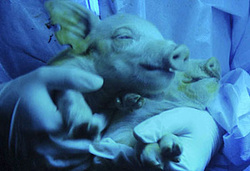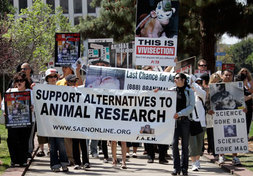So... Why Make Glowing Animals? by Tiffany Citra '17 
Sherlock Holmes in his signature style--and also, let's take a moment to appreciate his adorable smile [left], with his companion "bachelor" John Watson [right]. [image via]
Some of you are probably already familiar with the “science of deduction,” a term made famous by the ongoing BBC TV show Sherlock. Along with his partner John Watson, wearing his signature deerstalker and overcoat, this modern-day Sherlock Holmes roams the bustling streets of London trying to solve all sorts of crimes, from the elementary ones to the so-called “three-patch problems.” And because it has had too many fangirls’ Tumblr posts already, we think it’d be cool to show our love for this amazing TV show the not-so-mainstream way: by discussing the science behind it. Remember the “Hounds of the Baskerville”—the second episode of the second season, in which the 9-year-old Kirsty Stapleton filed a case about her “vanishing glow-in-the-dark rabbit” Bluebell? Bluebell is an example of genetic manipulation, which is the new kid on the block in the realm of biotechnology. We have been hearing about all sorts of benefits it may bring, from curing cancer to designing babies. The question, then, is why do some scientists spend their research, funding, and time to make animals… glow?  We also have glowing pigs! [image via] We also have glowing pigs! [image via] The good news is that fluorescent animals are not created solely for the sake of fun, or even worse, to create yet another consumerism trend aimed at little kids (like Kirsty). Scientists incorporate fluorescent proteins extracted from jellyfish DNA into other animals because it is a relatively simple indicator that they have successfully transferred the desired genes [1]. That is why during the episode, Dr. Stapleton—Kirsty’s mom—seems to take her job as a genetic researcher pretty seriously. Glowing animals is just a tiny, trivial fraction of the experiment. The final objective of producing transgenic animals—or genetic engineering for that matter, of course, goes way beyond this. This Sherlock episode, however, does not talk much about genetic engineering. Instead, it focuses more on the use of biological and chemical warfare, and hallucinogens in particular, which does not necessarily require genetic modification. That being said, with the advance of genetic engineering, it is possible to create a more dangerous bioweapon by incorporating certain genes from bacteria or modifying a pathogen to attack specific parts of human genome [2]. This, perhaps, is the most concerning downside of genetic engineering. Fortunately, the other side of genetic modification is much less depressing. In fact, it is not at all! One example of the primary goals of genetic engineering is to increase our ability to treat diseases. Experimenting on glowing animals also aims to find a cheaper way to mass-produce medicines. Genetically engineered animals are expected to be able to synthesize enzymes effective in combating certain diseases such as hemophilia [3]. This method would cost much less compared to medicines produced by pharmaceutical companies. Some researchers have taken a further step in making use of transgenic animals, and pigs in particular—organ transplant. Lord Robert Winston from the Institute of Reproductive and Developmental Biology at Hammersmith Hospital in London claimed that pigs’ organs are the most suitable ones for humans in terms of functionality and size [4]. In 2007, along with his team at Imperial College, Winston tried to breed pigs injected with six human genes in order to reduce the probability of their organs being rejected by human transplant patients. Unfortunately, so far, the outcome of this experiment itself has not yet been publicized.  A protest against animal research. [image via] A protest against animal research. [image via] That being said, however, the future of transgenic animals for medical use still remains uncertain. Despite its potential, there are certain ethical issues concerning genetic engineering [5]. Concern about animal welfare is perhaps the main reason why some people oppose transgenic animals. Another issue is regarding intellectual property, in which patenting either the methods or the products of genetic engineering may lead to “confidentiality culture” within the scientific community. This concern, of course, is perfectly understandable. After all, the primary goal of science and technology is to improve quality of life for everyone, not to be abused by certain groups or individuals for their own personal benefits.
0 Comments
Leave a Reply. |
